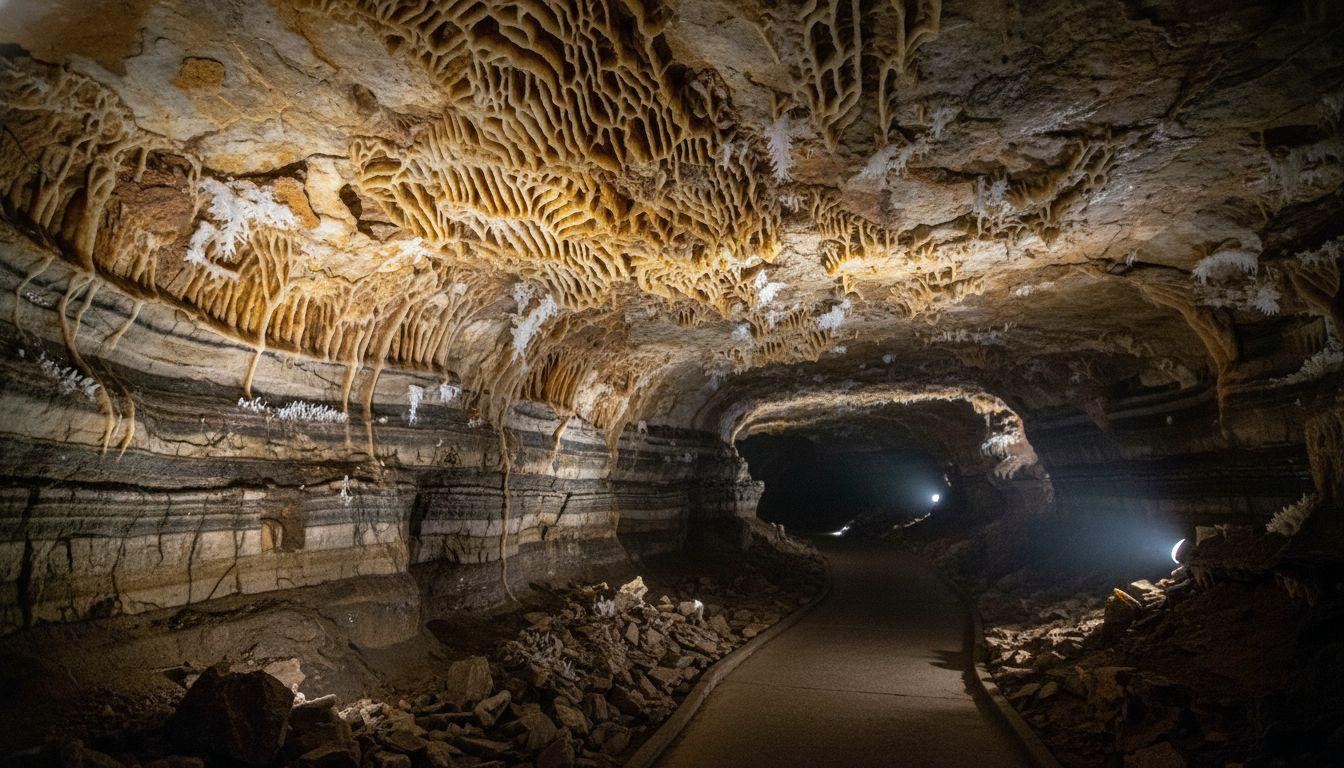November light touches Mount Rushmore’s granite faces while 220 miles of crystalline passages stretch silent beneath your feet. Three extraordinary cave systems hide within 40 miles of South Dakota’s most photographed monument, yet receive a fraction of the crowds. While 2 million tourists photograph presidents carved in stone, fewer than 800,000 annually descend into golden limestone cathedrals where boxwork patterns create natural geometric art and calcite crystals glitter like frozen waterfalls. This is the Black Hills’ overlooked truth: its most spectacular landscapes exist underground.
Three cave systems, one geological masterpiece
Wind Cave National Park (established 1903), Jewel Cave National Monument, and Black Hills Caverns form a triangle of underground wonder spanning just 40 miles. Wind Cave protects 168 miles of passages featuring the world’s largest concentration of boxwork formations found almost nowhere else on Earth.
Jewel Cave extends 220 miles (world’s 3rd-longest cave), its walls encrusted with calcite crystals that sparkle like gemstones under artificial light. Black Hills Caverns, privately operated since 1939, offers the most intimate experience with three-level tours showcasing formations followed by hands-on gemstone panning.
Twenty miles from Rapid City, all three caves remain accessible by rental car ($60-100/day) with tour costs of $10-35. This frontier town where Victorian facades rise above cobblestones unchanged since 1876 sits 40 miles north, making Deadwood the perfect historic complement to geological exploration.
What 440 million years creates
Formations found nowhere else
Wind Cave’s boxwork defies easy explanation. Thin calcite fins form honeycomb patterns across ceilings and walls, created when mineral-filled cracks in limestone remained after softer rock eroded away. Ninety-five percent of Earth’s boxwork exists here.
Jewel Cave counters with calcite nail heads (translucent crystals projecting from walls), hydromagnesite balloons (delicate mineral formations resembling clouds), and cave bacon (wavy flowstone sheets striped brown and white). Black Hills Caverns showcases frost crystals coating passages in what appears to be underground winter.
The Lakota connection
Indigenous oral traditions speak of underground passages centuries before 1882 European discovery. The Lakota name for Wind Cave translates to “hole that breathes” referencing barometric winds that rush in or out of the cave entrance depending on atmospheric pressure, sometimes with audible whistling.
Modern visitors still feel this breathing phenomenon at Wind Cave’s natural entrance. According to tribal historians, Wind Cave represents where souls emerged from the earth before creation. This sacred connection adds profound depth to the geological wonder visitors experience today.
Going underground in November 2025
Tours for every comfort level
Wind Cave offers five tour options ranging from the 1-hour Garden of Eden Tour (paved, wheelchair-accessible, $12 adult) to the 4-hour Wild Cave Tour (crawling required, $30). Jewel Cave’s Scenic Tour covers half a mile in 80 minutes ($12-15) while the Lantern Tour recreates 1930s exploration conditions.
Black Hills Caverns provides unique three-level access covering upper, middle, and lower chambers showcasing formation variety in 30-40 minutes ($25-35). This park where 750-foot sand dunes rise golden beneath snow-capped mountain peaks offers similar overlooked natural wonders with minimal crowds.
Beyond the caves
Black Hills Caverns distinguishes itself with gemstone panning ($10-15). Families sift mining concentrate containing actual amethyst, rose quartz, and calcite specimens. Unlike tourist-trap experiences, this uses genuine Black Hills mining material.
The experience combines underground geology with tactile discovery kids remember better than passive sightseeing. Late fall means minimal wait times and comfortable 55°F cave temperatures while surface weather cools to 45-65°F.
Why Mount Rushmore’s shadow matters
The irony runs deep: Theodore Roosevelt’s carved face overlooks Wind Cave, the national park he established in 1903. America’s first cave national park and 7th national park overall receives fraction of attention compared to his granite profile.
This juxtaposition creates rare travel mathematics: extraordinary natural features with minimal crowds because famous monuments draw attention elsewhere. Entrance to Wind Cave National Park costs nothing. Surface hiking through ponderosa pine and mixed-grass prairie adds another dimension.
This alpine pool where steam rises from 81-degree water at 4,800 feet elevation represents similar underground geological attractions with family-friendly accessibility. The Black Hills reveal their true nature underground.
Your Questions About Black Hills Caves Answered
When should you visit these caves?
Late spring (May-June) and early fall (September-October) offer optimal conditions with comfortable surface temperatures, minimal crowds, and full tour schedules. November brings even fewer visitors though some tour times reduce. Caves maintain constant 47-55°F year-round, so bring light layers regardless of surface weather.
How do these compare to commercial caves?
Wind and Jewel Cave tours cost $10-15 versus $25-35 for Carlsbad Caverns or Mammoth Cave. The formations rival or exceed famous caves while crowds remain fraction of the size. Black Hills Caverns adds gemstone panning with genuine mining material, not tourist-salted experiences.
What makes Black Hills cave formations unique?
Wind Cave contains 95 percent of Earth’s boxwork formations. Jewel Cave’s 220 miles make it the world’s 3rd-longest cave. These aren’t tourist-created superlatives but verified geological distinctions. This Indiana town where morning light cuts through a 200-foot glass dome above mineral springs offers comparable Midwest hidden treasures at fraction of coastal destination costs.
Dawn light catches crystalline walls 400 feet underground while calcite formations glitter like frozen water in artificial glow. Above, traffic streams toward Mount Rushmore’s parking lots. Below, passages stretch silent through 440-million-year-old limestone where South Dakota’s most extraordinary landscapes hide beneath the monument everyone photographs.
